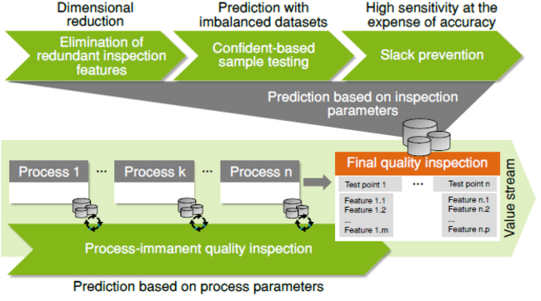Collaborative Research Centre 876

SFB876 Availability of Information through Analysis under Resource Constraints (Subproject B3: Data Mining in Sensor Data of Automated Processes)
(Project duration phase 3: January 2019 to December 2022; project work is carried out in cooperation with the Chair of Artificial Intelligence at the Faculty of Computer Science)
Problem
To meet the new challenges of producing increasingly individualised products with short lead times and higher quality, optimal and real-time decision support methods must be researched and developed. Errors that are only detected at the end of a production process can lead to a high number of rejects. For this reason, it is necessary to continuously monitor and check the quality of intermediate products.
In connection with the progressive spread of modern information and communication technologies, new possibilities for real-time data acquisition and analysis are emerging that make it possible to identify critical process patterns and take timely countermeasures.
Objective
The goal of efficient zero-defect production requires the development of resource-saving methods for real-time monitoring of production processes and prediction of quality-relevant characteristics. By learning from sensor data, real-time predictions can be made about product quality, which are used to intervene in the production process in a targeted manner and thus increase quality. While the project is focused on closing gaps in scientific research, transferability of the results to real industrial applications should not be neglected. To ensure this transfer, the developed methods need to be validated and evaluated on real data, which originate from real use cases and are associated with corresponding limitations.
The tasks and challenges of industrial data analysis in production systems were explored sequentially according to their requirements and complexity:
(1) anomaly detection,
(2) diagnostic analytics,
(3) predictive analytics, and
(4) prescriptive analytics.
While anomaly detection seeks to identify unusual and conspicuous patterns and behaviours, diagnostic analytics seeks to explain them through captured measurement and process data. Predictive analytics additionally tries to predict such anomalies before they actually occur in the process. Finally, prescriptive analytics should serve to determine measures based on prediction that are suitable for preventing the occurrence of anomalies and thus improving product quality.

Procedure
The third project phase serves to research and develop methods for prescriptive analytics with a focus on quality control in production systems. Building on research results already achieved, measurement and process data along the production process will be used to predict quality-relevant product properties. On the one hand, this prediction enables the quality-oriented control and adjustment of production processes to improve product quality. On the other hand, the predictive models can be used to improve quality inspection in terms of increased economic efficiency through reduced defect and inspection costs.
Funding Reference
The sub-project B3 "Data Mining in Sensor Data of Automated Processes" of the SFB 876 "Availability of Information through Analysis under Resource Constraints" is funded by the German Research Foundation.


![[Translate to English:] [Translate to English:]](/storages/zentraler_bilderpool/_processed_/2/6/csm_Altes_Maschinenbau-Gebaeude_3a1a87015a.jpg)